![へ – Marking Direction ‘Toward’ in Japanese [JLPT N5]](http://hirakan.com/cdn/shop/articles/he-marking-direction.jpg?v=1762667986&width=1100)
へ – Marking Direction ‘Toward’ in Japanese [JLPT N5]
Aktie
Quick Summary
Meaning: The particle へ marks direction or “toward” a place or person. It points where something is headed, not where it arrives.
How to Use: Put へ after a place or person, before a verb of movement or sending.
Example:
- 月へ行きます。
- Tsuki e ikimasu.
- I go to the moon.
Overview
Use へ to show the direction of movement, like “toward” in English. It is common with simple movement verbs such as 行きます (ikimasu, to go), 来ます (kimasu, to come), and 帰ります (kaerimasu, to return). It can also point toward a person when you send or address something, with verbs like 送ります (okurimasu, to send) or 書きます (kakimasu, to write).
Important nuance: へ emphasizes the direction/route. The particle に usually emphasizes the exact destination/arrival. Both are correct in many cases, but the feeling is slightly different. As a beginner, you can safely use both with 行きます (ikimasu, to go); learn the nuance step by step.
Pronunciation tip: the particle へ is pronounced “e” (not “he”).
What へ does not do: it does not mark time (use に), and it does not mark the place where an action happens (use で). Also, for existence verbs like あります (arimasu, to exist for things) and います (imasu, to exist for people/animals), use に to mark location.
Structure / Formation
Base Patterns
- Place + へ + V (movement)
- Person + へ + N + を + V (send/say/write)
- N1 + から + N2 + へ + V (movement from N1 toward N2)
How It Works
With movement verbs such as 行きます (ikimasu, to go), 来ます (kimasu, to come), and 帰ります (kaerimasu, to return), へ shows where you are headed. Think of it as drawing an arrow from you toward the place. With sending or addressing verbs like 送ります (okurimasu, to send) and 書きます (kakimasu, to write), へ marks the receiver or target person.
Common Movement Verbs
| Verb (ます-form) | Romaji | Meaning |
|---|---|---|
| 行きます | ikimasu | to go |
| 来ます | kimasu | to come |
| 帰ります | kaerimasu | to return (go back) |
Examples
- ペンギンは北へ走ります。
- Pengin wa kita e hashirimasu.
- The penguin runs toward the north.
- ロボットは先生へメールを送ります。
- Robotto wa sensei e mēru o okurimasu.
- The robot sends an email to the teacher.
Usage Tips
- Direction vs. arrival: へ feels like “toward,” に feels like “to (arrive at).” For beginners, both are fine with 行きます (ikimasu, to go); learn the nuance gradually.
- Pronunciation: The particle へ is read “e.”
- Letters and messages: You can address someone with “Name + へ” at the top of a letter or message to mean “To Name.”
Example Sentences
- サボテンは図書館へ行きます。
- Saboten wa toshokan e ikimasu.
- The cactus goes to the library.
- ドラゴンが家へ来ます。
- Doragon ga ie e kimasu.
- A dragon comes to my house.
- かめは学校から海へ帰ります。
- Kame wa gakkou kara umi e kaerimasu.
- The turtle returns from school to the sea.
- 金魚は山へ泳ぎません。
- Kingyo wa yama e oyogimasen.
- The goldfish does not swim toward the mountain.
- 妹へ手紙を書きました。
- Imouto e tegami o kakimashita.
- I wrote a letter to my little sister.
Quick Practice
(Answers and explanations are right under this section.)
Multiple-Choice
1. Choose the sentence that uses へ correctly to show direction.
- A. 猫は川へ走ります。 (Neko wa kawa e hashirimasu.)
- B. 猫は川で走ります。 (Neko wa kawa de hashirimasu.)
- C. 猫は川でも走ります。 (Neko wa kawa demo hashirimasu.)
- D. 猫は川と走ります。 (Neko wa kawa to hashirimasu.)
2. Choose the correct polite past sentence: “Yesterday, we went to the museum.”
- A. 昨日、私たちは博物館へ行きました。 (Kinou, watashitachi wa hakubutsukan e ikimashita.)
- B. 昨日、私たちは博物館で行きました。 (Kinou, watashitachi wa hakubutsukan de ikimashita.)
- C. 昨日、私たちは博物館と行きました。 (Kinou, watashitachi wa hakubutsukan to ikimashita.)
- D. 昨日、私たちは博物館や行きました。 (Kinou, watashitachi wa hakubutsukan ya ikimashita.)
3. Choose the correct way to address “To the teacher” at the top of a message.
- A. 先生へ。 (Sensei e.)
- B. 先生に。 (Sensei ni.)
- C. 先生で。 (Sensei de.)
- D. 先生と。 (Sensei to.)
4. Choose the sentence that correctly uses から and へ for movement.
- A. タコは学校から海へ帰ります。 (Tako wa gakkou kara umi e kaerimasu.)
- B. タコは学校から海で帰ります。 (Tako wa gakkou kara umi de kaerimasu.)
- C. タコは学校で海へ帰ります。 (Tako wa gakkou de umi e kaerimasu.)
- D. タコは学校から海へあります。 (Tako wa gakkou kara umi e arimasu.)
5. Choose the correct negative sentence with へ: “Grandma does not come to Tokyo.”
- A. 祖母は東京へ来ません。 (Sobo wa Toukyou e kimasen.)
- B. 祖母は東京で来ません。 (Sobo wa Toukyou de kimasen.)
- C. 祖母は東京と来ません。 (Sobo wa Toukyou to kimasen.)
- D. 祖母は東京に来ません。 (Sobo wa Toukyou ni kimasen.)
Spot-the-Error
6. One sentence has an error with へ. Which one is wrong?
- A. 猫は店へ走ります。 (Neko wa mise e hashirimasu.)
- B. 明日へ公園に行きます。 (Ashita e kouen ni ikimasu.)
- C. 兄へメッセージを送ります。 (Ani e messeeji o okurimasu.)
7. One sentence has an error with へ. Which one is wrong?
- A. 家へ帰ります。 (Ie e kaerimasu.)
- B. 学校へ先生がいます。 (Gakkou e sensei ga imasu.)
- C. 友だちへ手紙を書きます。 (Tomodachi e tegami o kakimasu.)
Translation
8. Translate into Japanese using へ: “The robot goes toward the station.”
9. Translate into Japanese using へ: “To Grandma: thank you.”
10. Translate into Japanese using へ: “The dog runs from the park toward the river.”
Answers and Explanations
- A. 猫は川へ走ります。 (Neko wa kawa e hashirimasu.) — へ marks the direction “toward the river,” which is the intended meaning.
- A. 昨日、私たちは博物館へ行きました。 (Kinou, watashitachi wa hakubutsukan e ikimashita.) — Use へ with 行きました to show the destination; the other particles don’t show direction.
- A. 先生へ。 (Sensei e.) — へ is the natural way to write “To [person]” at the top of a message.
- A. タコは学校から海へ帰ります。 (Tako wa gakkou kara umi e kaerimasu.) — から marks the starting point and へ marks the direction/destination with a movement verb.
- A. 祖母は東京へ来ません。 (Sobo wa Toukyou e kimasen.) — へ correctly marks “toward Tokyo”; the prompt asks for a sentence using へ.
- B is the error: 明日へ公園に行きます。 (Ashita e kouen ni ikimasu.) — へ cannot mark time; say 明日、公園に行きます。 (Ashita, kouen ni ikimasu.)
- B is the error: 学校へ先生がいます。 (Gakkou e sensei ga imasu.) — あります/います use に for location, not へ; say 学校に先生がいます。 (Gakkou ni sensei ga imasu.)
- ロボットは駅へ行きます。 (Robotto wa eki e ikimasu.) — へ shows the direction toward the station with 行きます.
- おばあちゃんへ、ありがとうございます。 (Obaachan e, arigatou gozaimasu.) — へ addresses the message “To Grandma.”
- 犬は公園から川へ走ります。 (Inu wa kouen kara kawa e hashirimasu.) — から marks “from” and へ marks “toward” for movement.
Related Posts
-
![に – Marking Time, Destinations, and Recipients in Japanese [JLPT N5]](//hirakan.com/cdn/shop/articles/ni-marking-destination.jpg?v=1762667846&width=170)
に – Marking Time, Destinations, and Recipients in Japanese [JLPT N5]
Quick Summary Meaning: The particle に marks a point in time (at/on), a destination you reach (to/into), or a target/r...
-
![の – Possession and Noun Linking in Japanese [JLPT N5]](//hirakan.com/cdn/shop/articles/no-possession-and-noun-linking.jpg?v=1761961297&width=170)
の – Possession and Noun Linking in Japanese [JLPT N5]
Quick Summary Meaning: Links two nouns to show possession, belonging, or description. Often reads as “’s” or “of....
-
![を – Marking the Direct Object in Japanese [JLPT N5]](//hirakan.com/cdn/shop/articles/o-direct-object.jpg?v=1761960990&width=170)
を – Marking the Direct Object in Japanese [JLPT N5]
Quick Summary Meaning: を marks the direct object — the thing that receives the action of a verb. It’s pronounced ...
-
![が – Marking the Subject ('Who/What') in Japanese [JLPT N5]](//hirakan.com/cdn/shop/articles/ga-subject-marker_60f30f70-6ca5-47ee-9a00-3646195d7d3c.jpg?v=1761386355&width=170)
が – Marking the Subject ('Who/What') in Japanese [JLPT N5]
Quick Summary Meaning: The particle が marks the subject of a sentence and highlights new or focused information (an...
-
![は (wa) – Topic Marker and Contrast in Japanese [JLPT N5]](//hirakan.com/cdn/shop/articles/wa-topic-marker.jpg?v=1761385996&width=170)
は (wa) – Topic Marker and Contrast in Japanese [JLPT N5]
Quick Summary Meaning: Marks the topic of the sentence — what you’re talking about. Often feels like “as for...” in E...
-
![じゃない・ではありません – Expressing 'Is/Was Not' in Japanese [JLPT N5]](//hirakan.com/cdn/shop/articles/janai-dehaarimasen_2594963b-531e-4f4d-a9b0-361010e0a720.jpg?v=1760865884&width=170)
じゃない・ではありません – Expressing 'Is/Was Not' in Japanese [JLPT N5]
Quick Summary Meaning: The negative of the copula “to be.” Say “is not” or “was not” with nouns and na-adjectives. Ho...
-
![だ・です/だった・でした – Saying ‘to be’ in Japanese [JLPT N5]](//hirakan.com/cdn/shop/articles/da-desu-datta-deshita_58bbc732-53fd-48da-83c7-4e477e7cc0b2.jpg?v=1760864506&width=170)
だ・です/だった・でした – Saying ‘to be’ in Japanese [JLPT N5]
Quick Summary Meaning: The Japanese copula — the basic “to be.” It links a topic to a noun or a na-adjective to state...
-

Common Japanese Onomatopoeia: Essential Words You’ll Hear Everywhere
If you spend any time in Japan, you’ll hear onomatopoeia everywhere: on TV, in everyday conversations, in manga, and ...
-

How to Say “To Increase” and “To Decrease” in Japanese: With Examples
You've noticed there are multiple ways to say “to increase” or "to decrease" in Japanese. Between transitive and intr...
-

How to Say "Police Officer" in Japanese: Common Terms and Slang
There are several ways to say "police officer" in Japanese, and each one has a different level of formality and usage...
-
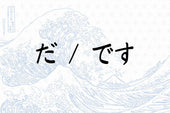
Understanding だ (da) and です (desu) in Japanese: Meaning and Usage
When learning Japanese, one of the first things you’ll come across is だ (da) and です (desu). These words don’t have a ...
-
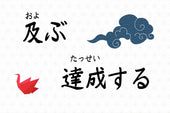
Difference Between 及ぶ (およぶ) and 達成する (たっせいする)
Both 及ぶ and 達成する can relate to "reaching" or "achieving" something, but they have distinct nuances and usage contexts...
-

JLPT N5 Study Guide: A Beginner's Roadmap to Acing the Test
If you’ve just started learning Japanese and are aiming to ace the JLPT N5, you’ll need a solid study guide to help y...
-

Beginner's Guide to Japanese Particles: Learn the Basics
TL;DR: Japanese particles are crucial for structuring sentences, acting like conjunctions or prepositions in English...
-

JLPT N5 Vocabulary List - All 748 Words You Need to Know
Vocabulary is the foundation of any language, and Japanese is no exception. The more you know, the better. Over time ...
-

JLPT N4 Kanij List - All 176 Characters You Need To Know
After mastering the JLPT N5 kanji, you're ready to take your Japanese kanji game to the next level. JLPT N4. Let's go...
-
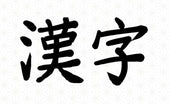
Kanji For Kanji - 漢字
Inception time. Which kanji compose the kanji of "kanji"? The kanji for "kanji" is actually pretty straightforward. I...
-

How to Memorize Katakana Easily: 9 Tips for Beginners
For those diving into Japanese, mastering hiragana and katakana is the first significant challenge. While hiragana o...
-

Complete Hiragana and Katakana Chart With All 112 Characters
The very first step for everybody who wants to learn Japanese is to study the hiragana and katakana chart (before lea...
-
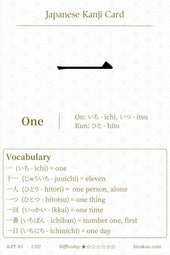
JLPT N5 Kanji: Kanji For One 一 (ichi)
Probably one the most simple kanji to remember, the kanji for 'one' is simply written '一'. Let's see its readings and...
-
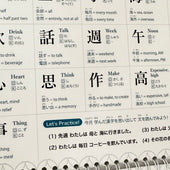
How Long Does It Take to Learn Kanji? A Beginner's Guide
Ask any Japanese student what's the scariest part of learning the language, and they'll say kanji. And they're righ...
-

Is it Necessary to Learn Kanji? The Last Answer You'll Ever Need
Many beginners in Japanese wonder whether they should really learn kanji. I know this, because I also wondered when s...
-

How Long Does it Take to Learn Hiragana and Katakana?
As a beginner in Japanese, your first step is diving into the alphabets of Hiragana and Katakana. These are the build...
-

13 Best YouTube Channels to Learn Japanese, From Beginner to Intermediate
YouTube can be an incredible resource for learning Japanese. And best of all, it's free. So we've compiled a list of ...
-
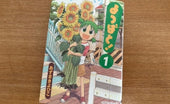
Top 10 Manga for Japanese Language Learners: From Beginners to Intermediates!
If you're learning Japanese, chances are you're interested in manga. So instead of reading texts about Tanaka-san s...
-
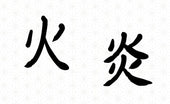
Kanji für „Feuer“ auf Japanisch: 火 oder 炎?
Willkommen zu unserer aufschlussreichen Erkundung des japanischen Kanji! Heute entfachen wir unser Verständnis ein...
-

Der vollständige Leitfaden zu Ländernamen auf Japanisch: Sagen Sie sie richtig und sprechen Sie sie richtig aus!
Egal, ob Sie eine Reise planen, Japanisch lernen oder einfach nur wissen möchten, wie verschiedene Länder in einer an...
-
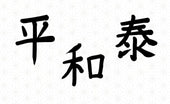
Kanji für Frieden: 平, 和, 泰 – Die Symbole der Harmonie
Sie fragen sich vielleicht, was die japanischen Symbole für „Frieden“ sind. In diesem Artikel tauchen wir tief in ...
-
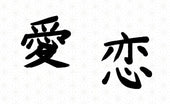
Kanji für „Liebe“: Wie und wann man 愛 und 恋 verwendet
Willkommen auf unserer Reise in die Welt des japanischen Kanji! Heute beschäftigen wir uns mit einem der herzerwär...
-
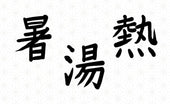
Kanji für „Hot“ auf Japanisch: 暑, 湯 und 熱 – Ein umfassender Leitfaden
Willkommen auf unserer Reise in die Welt des japanischen Kanji! Heute werden wir uns mit einem spannenden und wese...
-
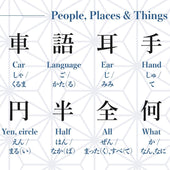
JLPT N5 Kanji-Liste – Alle 112 Zeichen, die Sie kennen müssen
Wenn Sie sich zum Ziel gesetzt haben, die JLPT N5-Prüfung zu bestehen, ist eines sicher: Ein fester Umgang mit Kanji ...

![に – Marking Time, Destinations, and Recipients in Japanese [JLPT N5]](http://hirakan.com/cdn/shop/articles/ni-marking-destination.jpg?v=1762667846&width=170)
![の – Possession and Noun Linking in Japanese [JLPT N5]](http://hirakan.com/cdn/shop/articles/no-possession-and-noun-linking.jpg?v=1761961297&width=170)
![を – Marking the Direct Object in Japanese [JLPT N5]](http://hirakan.com/cdn/shop/articles/o-direct-object.jpg?v=1761960990&width=170)
![が – Marking the Subject ('Who/What') in Japanese [JLPT N5]](http://hirakan.com/cdn/shop/articles/ga-subject-marker_60f30f70-6ca5-47ee-9a00-3646195d7d3c.jpg?v=1761386355&width=170)
![は (wa) – Topic Marker and Contrast in Japanese [JLPT N5]](http://hirakan.com/cdn/shop/articles/wa-topic-marker.jpg?v=1761385996&width=170)
![じゃない・ではありません – Expressing 'Is/Was Not' in Japanese [JLPT N5]](http://hirakan.com/cdn/shop/articles/janai-dehaarimasen_2594963b-531e-4f4d-a9b0-361010e0a720.jpg?v=1760865884&width=170)
![だ・です/だった・でした – Saying ‘to be’ in Japanese [JLPT N5]](http://hirakan.com/cdn/shop/articles/da-desu-datta-deshita_58bbc732-53fd-48da-83c7-4e477e7cc0b2.jpg?v=1760864506&width=170)























